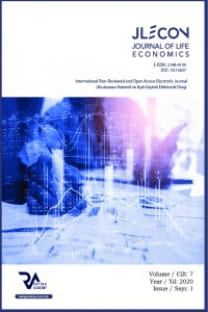THE EXPORT DETERMINANT OF SOCIO-ECONOMIC RESILIENCE IN FOREIGN ECONOMIC ACTIVITY
An undoubted advantage of the diversified economies is their less sensitivity to dynamics fluctuations of local sectors and shock destructions. A downturn in one industry can be compensated by growth in another. Formed in Soviet times significant industrial potential of Ukraine was not possible to implement only in the national economy. A significant part of Ukrainian manufacturing and extractive industries products was consumed by foreign consumers. Formed absolute and relative advantage in international trade ensured the enrichment of a limited set of stakeholders and have become the drivers of system economic crisis and the loss of Ukraine's ability to adsorb (to leap back) shock disturbance. The results of the analysis indicate the negative impact of resources specificity on the Ukraine's ability to ensure sustainable development. Proved the validity of conclusions about the negative effects of high exports concentration (low commodity diversification) on the economy's response from shock disturbances
Anahtar Kelimeler:
export determinant, socio-economic resilience, concentration, diversification, structural shifts.
THE EXPORT DETERMINANT OF SOCIO-ECONOMIC RESILIENCE IN FOREIGN ECONOMIC ACTIVITY
An undoubted advantage of the diversified economies is their less sensitivity to dynamics fluctuations of local sectors and shock destructions. A downturn in one industry can be compensated by growth in another. Formed in Soviet times significant industrial potential of Ukraine was not possible to implement only in the national economy. A significant part of Ukrainian manufacturing and extractive industries products was consumed by foreign consumers. Formed absolute and relative advantage in international trade ensured the enrichment of a limited set of stakeholders and have become the drivers of system economic crisis and the loss of Ukraine's ability to adsorb (to leap back) shock disturbance. The results of the analysis indicate the negative impact of resources specificity on the Ukraine's ability to ensure sustainable development. Proved the validity of conclusions about the negative effects of high exports concentration (low commodity diversification) on the economy's response from shock disturbances
Keywords:
export determinant, socio-economic resilience, concentration, diversification, structural shifts.,
___
- BURLUTSKIY, S., BURLUTSKII Sv. and MARGASOVA, V., (2019), The Relationship Between Short-Term Fluctuations and Stages of Economic Cycle: The Case of Ukraine, Revista ESPACIOS, 40 (10), 10-21.
- CHEN, Y., XIONG, X., (2014), An Empirical Analysis for Over-Sophisticated Export and Regional Economic Growth, Modern Economy, 5, 1114-1119.
- EPPS, T., (2013), Probability and statistical theory for applied researchers. World Scientific Publishing Company, ISBN 978-9814513159.
- NUR DİLBAZ ALACAHAN, YAĞMUR AKARSU, (2017), Foreign Trade Policy of European Union’s Effects on Turkish Economy, Journal of Life Economics, 4(1), 25-38.
- PRIGOGINE, I., (1957), The Molecular Theory of Solutions, Amsterdam: North Holland Publishing Company.
- RAFAEL ROMEU, NELSON CAMANHO DA COSTA NETO, (1999), Did Export Diversification Soften the Impact of the Global Financial Crisis?, IMF: Working Paper 11.
- SERENELLA SALAA, BIAGIO CIUFFOB and PETER NIJKAMPC, (2015), A Systemic Framework for Sustainability Assessmen, Ecological Economics, 119, 314-325.
- SZALAI, A. et al., (1972), The Use Of Time: Daily Activities Of Urban And Suburban Populations In Twelve Countries, Netherlands: The Hague Mouton.
- VAHALIK, B., (2015), Analysis of Export Diversification Development of the European Union and BRICS Countries, Ekonomická revue –Central European Review of Economic Issues, 18, 59-69.
- VON BERTALANFFY, L., (1968), General System Theory: Foundations, Development, New York: George Braziller, ISBN 978-0807604533.
- Yayın Aralığı: Yılda 4 Sayı
- Başlangıç: 2014
- Yayıncı: Rating Academy
Sayıdaki Diğer Makaleler
THE EFFECTS OF EMOTIONS ON RISK AVERSION BEHAVIOR
Mualla AKÇADAĞ, Tuba AHISKALI BOZKURT
THE EXPORT DETERMINANT OF SOCIO-ECONOMIC RESILIENCE IN FOREIGN ECONOMIC ACTIVITY
Serhii BURLUTSKYI, Svitlana BURLUTSKA, Tamara BEREZIANKO
THE EFFECTS OF LOGISTICAL AND SUPPLY CHAIN ON THE PERFORMANCE OF SHALLOT FARMERS EAST JAVA
La Ode Andi HERMAWAN, Arik PRASETYA, Saparila WOROKINASIH
İHRACAT KREDİ SİGORTASI, İHRACAT ARTIŞI VE İKTİSADİ BÜYÜMEYE ETKİSİ: TÜRKİYE ÖRNEĞİ
Müge ÇETİNER, Selda EKE, Ahmet Erdal PEKER
